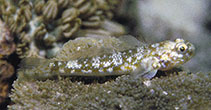| Family: |
Gobiidae (Gobies), subfamily: Gobiinae |
| Max. size: |
12 cm TL (male/unsexed) |
| Environment: |
reef-associated; brackish; marine; depth range 0 - 10 m |
| Distribution: |
Indo-Pacific: East Africa to Johnston, Marquesas and Tuamoto islands, north to southern Japan, south to the southern Great Barrier Reef and Rapa Islands; Marianas and Marshall Islands in Micronesia. Misidentified as Bathygobius fuscus in Hawaii (Ref. 7490). |
| Diagnosis: |
Dorsal spines (total): 7-7; Dorsal soft rays (total): 9-9; Anal spines: 1-1; Anal soft rays: 8-8. Characterized by mottled brown overall color, with five alternating irregular whitish and brown blotches or saddles dorsally on body; lower half of side with 5-7 rectangular brown blotches; white spots and blotches on cheek and operculum; upper 4-5 pectoral rays branched to base, tips membrane-free; rounded caudal fin; longitudinal scale series 37-38; predorsal scales 10-12, nearly reaching to above rear margin of preopercle; scales absent on cheek and operculum; ctenoid body scales, becoming cycloid on abdomen, breast and nape; depressed head, width greater than depth; depth of body 5.0 in SL (Ref. 90102). |
| Biology: |
Lives among rubble, in sand pockets, or on reef rock and is abundant on silty intertidal reef flats (Ref. 9360, 58302). Benthic (Ref. 58302). Gut analysis composed of polychaetes, isopods, amphipods, and brachyurans (Ref. 9360, 48637). |
| IUCN Red List Status: |
Least Concern (LC); Date assessed: 19 July 2017 Ref. (130435)
|
| Threat to humans: |
harmless |
| Country info: |
Type locality, tide pool at Nasugbu, Batangas Prov., Luzon Island, SU 32989 (holotype of Gobius elmeri) (Ref. 280, 50838). |
Source and more info: www.fishbase.org. For personal, classroom, and other internal use only. Not for publication.

